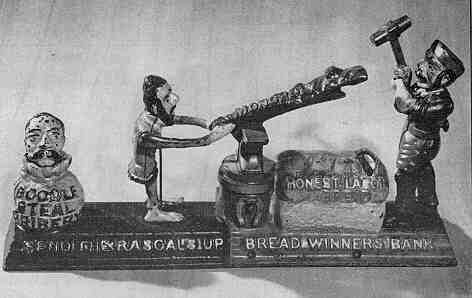Bread Winners Bank
by F.H. Griffith - HOBBIES Magazine - May, 1952

The articles in this series have reached a point where we now have a fair size group of rare wanted banks which are difficult to classify numerically. Here we enter into a phase where personal opinion and preference would govern, to a large degree, the numerical listing. In other words, there are a number of banks that are quite rare and desirable which are all on a fairly equal level. In this group there is a fine dividing line in ranking one ahead of the other.
The Bread Winners Bank is ranked in eighth position due to its nice action and rarity plus the two additional features involving the clever inference to the labor problem of that period. Also there are very few specimens that are in original condition without repairs.
There are no patent markings, numbers, or dates on the Bread Winners Bank, and to the best of the writer’s knowledge, the design of the bank was never patented. Using the figures on the bank as a guidepost there are definite characteristics indicating the work of Charles Bailey and it is known that the bank was manufactured by the J.&E. Stevens Company of Cromwell, Connecticut, in the 1880’s.
The bank pictured was obtained by the writer in an antique shop on Charles Street in Boston, Massachusetts, a few years ago. It was found by the dealer in a house in New Hampshire where it had been packed away for years in a trunk in an attic. The fact that the bank had been carefully packed away for sometime, no doubt, accounts for the excellent condition of the paint and also that it is original throughout with no repairs of any kind.
On each side of the base of the bank there are inscriptions. On the left are the words "Send The Rascals Up" and on the right "Bread Winners Bank." A figure of a banker with his head sticking out of a sack is shown. The sack bears the wording "Boodle, Steal, Bribery." The rascal in the center is holding a club in his hands and on this is written the word "Monopoly." On the loaf of bread which is to the right of the anvil is inscribed "Honest Labor Bread." The figure on the end represents an honest laborer who is being threatened by the rascal. The significance of this is the familiar controversy between labor and capitalism, the banker shown up to his neck in boodle (or money) using the rascal by bribery to wave the club of monopoly at labor who in turn is trying to earn an honest living.
To operate the bank the hammer is raised to the position shown in the picture, then a coin is inserted in the end of the club held by the rascal. There is a small lever in the back of the laborer which is pressed. This causes the hammer to come down with a sound blow on the club held by the rascal. He flies up in the air and the coin is deposited in the loaf of bread. The story portrayed by this action of course is that labor wins over monopoly and the wealthy banker.
The operation of the bank and the way it is made are two reasons there are so few in original condition. In the first place construction of the labor figure is such that the operation of the spring mechanism usually causes the casting of the figure to break. Also the figure of the rascal is loosely attached to the bank and is usually missing. Due to its rather delicate construction very few of the banks remained intact after any slight degree of rough treatment which could be expected as these banks were still essentially children’s toys.
The bank is painted in bright colors, the base being red on one side and blue on the other and the figures themselves are painted realistically.
To sum it all up, the Bread Winners Bank, is an extremely desirable specimen to have in a collection not only because it is rare and its action interesting, but also it stands out from all the rest with its theme of a seemingly never ending controversy.
